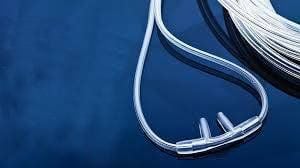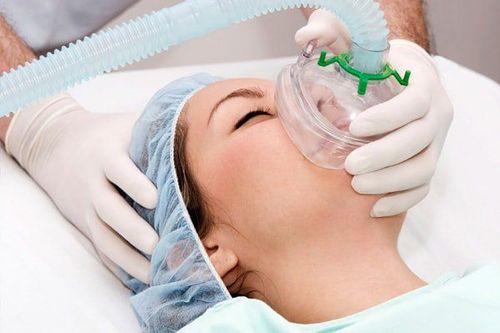This is an automatically translated article.
Oxygen therapy is indicated for patients with manifestations of hypoxia such as low oxygen concentration or low arterial oxygen saturation. Breathing oxygen through the nose and tracheostomy tube helps to provide oxygen to the patient for the purpose of reducing shortness of breath, preventing and treating hypoxia.
1. Method of breathing oxygen for the patient
1.1 Oxygen therapy
Oxygen therapy is a method of providing oxygen to a patient with the aim of preventing or reducing hypoxia. Any patient with inadequate tissue oxygenation can receive additional oxygen from controlled oxygen delivery. Oxygen therapy is prescribed by the physician, to determine the specific concentration, method and volume in liters/min. But providing oxygen is an emergency measure, so the nurse can initiate therapy.
Oxygen therapy is a supportive measure, should only be used when prescribed by a doctor. Any medication, dose, or oxygen levels need to be continuously monitored. The nurse needs to check the doctor's orders regularly to determine the indicated oxygen concentration and should apply the same 5 check principles as giving the patient medication. Oxygen therapy is indicated for patients presenting with hypoxia (low oxygen concentration or low hemoglobin oxygen saturation in arterial blood). Hypoxia can be caused by the following:
Obstructions in the respiratory tract: sputum, foreign body, spasm or edema. Limited thoracic activity: respiratory muscle paralysis due to nerve damage, scoliosis, rib fracture caused by thoracic trauma, pneumothorax and pleural effusion. Nervous system function declines when participating in the respiratory process: encephalitis, traumatic brain injury and cerebrovascular accident. Diseases that interfere with the diffusion of air in the lungs such as pneumonia, acute pulmonary edema, emphysema, and bronchopneumonia. Diseases that disturb the process of transporting oxygen in the blood and circulation: anemia, heart failure, congenital heart disease. Symptoms of hypoxia of the patient depend on age, health, current medical condition and chronic disease. Signs of hypoxia include:
Rapid pulse. Rapid, shallow, or difficult breathing. Restlessness, dizziness. The nose bulges. Contraction of the intercostal space and the sternum. Purple green. Principles of oxygen therapy
1.2 General principles
General principles when giving oxygen to patients include:
Use the right dose, the right method: use the right dose and method as prescribed by the doctor to ensure adequate oxygen supply to the patient. patient. Any drug or oxygen is not completely harmless to the patient. Oxygen concentrations greater than 50% can lead to oxygen toxicity. To achieve the desired arterial oxygen saturation, the lowest oxygen concentration needed should be used. Prevention of infection when breathing oxygen for patients: oxygen is a favorable environment for bacteria to grow quickly, so it is necessary to ensure aseptic stage in the process of oxygen supply. Prevention of respiratory tract dryness: in the process of providing oxygen to the patient, it is necessary to moisten the oxygen before entering, and give the patient more water to drink if possible. Safety principles: it is important to ensure safety while using oxygen therapy, because it is easy to cause fire and explosion.

Liệu pháp oxy là phương pháp cung cấp oxy cho người bệnh
1.3 Oxygen delivery device
Oxygen is provided by two systems including: a closed system in the wall and a transport system such as a container, a bag. Dry oxygen is oxygen supplied from a tank or wall system. The disadvantage of dry oxygen is that it dehydrates the respiratory mucous membranes, so before giving it to the patient's respiratory tract, it is necessary to moisten the oxygen, especially when the inspiratory volume is more than 2 liters/min.
A variety of oxygen delivery devices are available including nasal cannula, nasal cannula, mask, oxygen tent, T-tube, or collar for artificial ventilation (endotracheal or bronchoscopy).
2. Breathe oxygen through a nasal cannula
Nasal cannula is a flexible and smooth oxygen tube, measuring about 40cm long. The distal end of the nasal cannula has many small openings through which oxygen can escape. The normal rate of oxygen flow through the nasal cannula is 1 to 6 l/min and the FiO2 is 24% to 40%. Nasal catheters have the advantage that they are available to any patient of any age, are cheap, and are used only once. However, nasal cannula have some limitations during use because they cause discomfort to the patient when used, they can stick to the nasal cavity and dry the oropharyngeal mucosa. In addition, oxygen therapy through the nasal cannula is time-consuming.
3. Breathing oxygen through a tracheostomy tube
Give oxygen through a tracheostomy tube with a T-tube or a collar in artificial ventilation (endotracheal or tracheostomy). For artificial ventilation, the oxygen supplied to the patient must always be humidified, because artificial ventilation does not pass through the usual airways of the mouth and nose. The two devices used to deliver humidified oxygen are the T-tube or the inner collar for the tracheostomy.
The T-tube is a device with a T-shape and an internal branch that supplies oxygen with an artificial airway (endotracheal or tracheostomy). The tracheostomy collar is a type of medical device with a curved face with a strap that can be adjusted to fit the patient's neck. There are two holes including one to connect to the oxygen source and one that is always open on the patient's side for ventilation.
4. Technical procedure for breathing oxygen through the nose and tracheostomy tube
4.1 Preparation
Prepare the patient: the medical staff will notify and explain to the patient or the patient's family in advance.
Prepare tools including:
Oxygen supply, flow meter, pressure gauge, lead and connection tube,... Humidifier according to the doctor's instructions. Nasal cannula, cannula, mask with appropriate size. Tape. Elastic rope for fixation. Wear hats, gloves, and masks. Prepare the medical staff:
Place the patient in an appropriate position and position. Prepare oxygen supply equipment and humidification system. Place the patient in the Fowler position.

Chuẩn bị dụng cụ thực hiện thở oxy qua mũi
4.2 Steps to take
Open oxygen according to the prescribed dose Using a suitable oxygen supply device Attach the flowmeter to the position where oxygen is released from the tank or from the duct. Fill the humidification bottle with distilled water, attach the bottle to the bottom of the flowmeter. Attach the oxygen tube and oxygen supply device to the humidifier. Give the required dose of oxygen For the nasal cannula
Measure the length of the nasal cannula by: measuring the distance from the patient's nostril to the earlobe and marking that landmark. Lubricate the nasal cannula with a water-soluble lubricating oil. Insert the catheter gently into one of the patient's nostrils, then thread the catheter along the floor of the nasal cavity and stop at the point previously marked. Examine the patient's oral cavity by pressing the tongue and the lamp. The tip of the nasal cannula is visible on the uvula, retract the tube about 0.6cm so that the tube is no longer visible. Helps the chest expand more easily. Ensure the oxygen delivery system to the patient needs to be tight and efficient. Ensure an effective and safe supply of oxygen at the right dose. Ensure privacy if the patient requests it. It is advisable to block the flow of oxygen during this period. Check the nasal cannula's oxygen delivery system carefully. Check if oxygen is passing through the tube. The catheter should not be twisted and the connection should be tight. There are always air bubbles in the humidifier when oxygen flows through. Check the oxygen flow at the tip of the cannula, nasal cannula, mask, and tent. Select the appropriate means depending on the patient's condition and available equipment at the ward. Ensure patient comfort, comfort and convenience. For T-tube or necklace.
Before attaching an oxygen breathing device, it is necessary to suck up secretions from the patient's pharynx. Attach the device to the oxygen supply and adjust the dose of oxygen as ordered. In summary, nasal oxygen and tracheostomy tubes are the means of providing oxygen to the patient when performing oxygen therapy. This helps the patient reduce shortness of breath, prevent and treat hypoxia. In the process of breathing oxygen, there may be some complications such as slippage, blockage of the breathing tube. Therefore, patients need to be continuously monitored for timely intervention.
Currently, at Vinmec International General Hospital, oxygen therapy through the nose is used in emergency and treatment cases to ensure the patient's health as well as maintain the patient's life. In addition, this is also the address for examination, treatment and prevention of many diseases with optimal results thanks to modern technical facilities, a team of dedicated, professional and dedicated doctors. profession.
Please dial HOTLINE for more information or register for an appointment HERE. Download MyVinmec app to make appointments faster and to manage your bookings easily.













